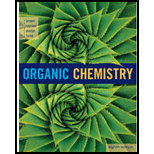
(a)
Interpretation:
The strength of Hydrogen bonding associated by
Concept Introduction:
Physical properties of ethers: Ethers are polar molecules in which Oxygen bears a partial negative charge and each attached to carbon bears a partial positive charge. Only weak dipole-dipole interactions exist between ether molecules in the liquid form. As ethers do not form hydrogen bonding are less soluble in water. Due to the presence of lone pairs on oxygen atom can act as hydrogen bond acceptors that makes them more water-soluble than hydrocarbons of comparable molecular weight.
Hydrogen bonding: The attractive interactions between hydrogen atom bonded to an atom of high electronegativity (most commonly O or N) and a lone pair of electrons on another atom of electrons on another atom of high electronegativity (again, most commonly O or N).
Boiling point: The temperature at which a liquid boils and turns into gas phase is known as boiling point.
(b)
Interpretation:
The boiling pointof the compounds associated by
Concept Introduction:
Physical properties of ethers: Ethers are polar molecules in which Oxygen bears a partial negative charge and each attached to carbon bears a partial positive charge. Only weak dipole-dipole interactions exist between ether molecules in the liquid form. As ethers do not form hydrogen bonding are less soluble in water. Due to the presence of lone pairs on oxygen atom can act as hydrogen bond acceptors that makes them more water-soluble than hydrocarbons of comparable molecular weight.
Hydrogen bonding: The attractive interactions between hydrogen atom bonded to an atom of high electronegativity (most commonly O or N) and a lone pair of electrons on another atom of electrons on another atom of high electronegativity (again, most commonly O or N).
Boiling point: The temperature at which a liquid boils and turns into gas phase is known as boiling point.
Want to see the full answer?
Check out a sample textbook solution
Chapter 10 Solutions
ORGANIC CHEMISTRY-OWL V2 ACCESS
- Indicate the products obtained by mixing 2,2-dimethylpropanal with acetaldehyde and sodium ethoxide in ethanol.arrow_forwardSynthesize 2-Ethyl-3-methyloxirane from dimethyl(propyl)sulfonium iodide using the necessary organic or inorganic reagents. Draw the structures of the compounds.arrow_forwardSynthesize 2-Hydroxy-2-phenylacetonitrile from phenylmethanol using the necessary organic or inorganic reagents. Draw the structures of the compounds.arrow_forward
- Synthesize N-Methylcyclohexylamine from cyclohexanol using the necessary organic or inorganic reagents. Draw the structures of the compounds.arrow_forwardSynthesize N-Methylcyclohexylamine from cyclohexanol using the necessary organic or inorganic reagents. Draw the structures of the compounds.arrow_forwardIf possible, please provide the formula of the compound 3,3-dimethylbut-2-enal.arrow_forward
- Synthesize 1,4-dibromobenzene from acetanilide (N-phenylacetamide) using the necessary organic or inorganic reagents. Draw the structures of the compounds.arrow_forwardIndicate the products obtained by mixing (3-oxo-3-phenylpropyl)triphenylphosphonium bromide with sodium hydride.arrow_forwardWe mix N-ethyl-2-hexanamine with excess methyl iodide and followed by heating with aqueous Ag2O. Indicate the major products obtained.arrow_forward
- Indicate the products obtained by mixing acetophenone with iodine and NaOH.arrow_forwardIndicate the products obtained by mixing 2-Propanone and ethyllithium and performing a subsequent acid hydrolysis.arrow_forwardIndicate the products obtained if (E)-2-butenal and 3-oxo-butanenitrile are mixed with sodium ethoxide in ethanol.arrow_forward
 ChemistryChemistryISBN:9781305957404Author:Steven S. Zumdahl, Susan A. Zumdahl, Donald J. DeCostePublisher:Cengage Learning
ChemistryChemistryISBN:9781305957404Author:Steven S. Zumdahl, Susan A. Zumdahl, Donald J. DeCostePublisher:Cengage Learning ChemistryChemistryISBN:9781259911156Author:Raymond Chang Dr., Jason Overby ProfessorPublisher:McGraw-Hill Education
ChemistryChemistryISBN:9781259911156Author:Raymond Chang Dr., Jason Overby ProfessorPublisher:McGraw-Hill Education Principles of Instrumental AnalysisChemistryISBN:9781305577213Author:Douglas A. Skoog, F. James Holler, Stanley R. CrouchPublisher:Cengage Learning
Principles of Instrumental AnalysisChemistryISBN:9781305577213Author:Douglas A. Skoog, F. James Holler, Stanley R. CrouchPublisher:Cengage Learning Organic ChemistryChemistryISBN:9780078021558Author:Janice Gorzynski Smith Dr.Publisher:McGraw-Hill Education
Organic ChemistryChemistryISBN:9780078021558Author:Janice Gorzynski Smith Dr.Publisher:McGraw-Hill Education Chemistry: Principles and ReactionsChemistryISBN:9781305079373Author:William L. Masterton, Cecile N. HurleyPublisher:Cengage Learning
Chemistry: Principles and ReactionsChemistryISBN:9781305079373Author:William L. Masterton, Cecile N. HurleyPublisher:Cengage Learning Elementary Principles of Chemical Processes, Bind...ChemistryISBN:9781118431221Author:Richard M. Felder, Ronald W. Rousseau, Lisa G. BullardPublisher:WILEY
Elementary Principles of Chemical Processes, Bind...ChemistryISBN:9781118431221Author:Richard M. Felder, Ronald W. Rousseau, Lisa G. BullardPublisher:WILEY





